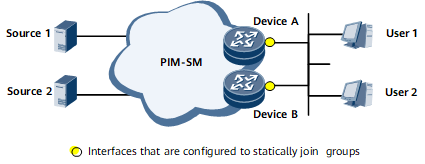IGMP Static-Group Join
Static-group is implemented by statically joining interfaces to groups. For example, on the network shown in Figure 1, after an interface on router A is added to a static group, router A will not start a timer for the multicast entry that contains the specified group address, and the multicast entry will never expire. Therefore, router A sends multicast data to User 1 in the static group, irrespective of whether this user is requesting the data. This entry cannot be automatically deleted, but can only be manually deleted when it is not needed any more.
In real-world situations, static-group is configured on the router interface that is connected to hosts, which facilitates multicast data forwarding to the router. The router interface can then quickly forward the multicast data, which shortens the channel switchover period.
